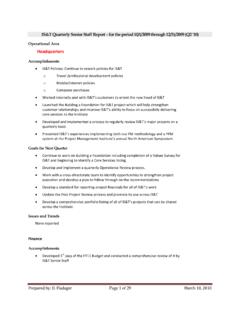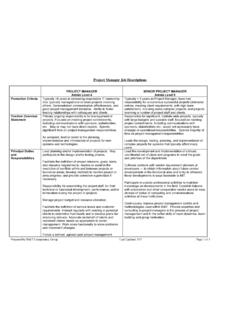Transcription of Microsoft Excel 2007 Basics For Windows
1 Copyright 2009 by Massachusetts Institute of Technology All Rights Reserved Printed on 12/8/09 Microsoft Excel 2007 Basics For Windows Microsoft Excel 2007 Basics for Windows Copyright 2009 Massachusetts Institute of Technology All Rights Reserved 2 of 41 Table of Contents Table of Contents .. 2 Module 1 Getting Started .. 5 Starting Microsoft Excel .. 5 Creating and Opening Workbooks .. 5 Creating a new workbook .. 5 Opening an existing workbook .. 6 Workbooks and Worksheets .. 6 Elements of a Window.
2 7 Title Bar and Menu Bar .. 7 Standard and Formatting Toolbars .. 9 Zoom Control .. 9 Active Cell .. 9 Cell Address .. 9 Horizontal and Vertical Scroll Bars .. 10 Name Box and Formula Bar .. 10 Row and Column Headings .. 11 Sheet Tabs and Tab Scrolling Buttons .. 11 Status Bar .. 12 Exercise - Module 1 .. 13 Module 2 Saving .. 14 Naming workbooks .. 14 Saving an unnamed workbook .. 14 Saving an existing workbook .. 14 Saving a copy of a workbook .. 14 Saving a workbook to a new location .. 15 Saving a workbook with a new name and to a new location.
3 15 Exercise - Module 2 .. 16 Module 3 Entering and Editing .. 17 Entering Worksheet Data .. 17 Enter numbers, text, a date, or a time .. 17 Ready and Edit modes .. 17 Enter and edit the same data on multiple worksheets .. 18 Enter the same data into several cells at once .. 18 Automatically fill in data based on adjacent cells .. 18 Microsoft Excel 2007 Basics for Windows Create a Custom List .. 19 Import an existing Custom List .. 19 Editing Worksheet Data .. 19 Edit cell contents .. 19 Cancel , undo or redo an entry.
4 20 Clear contents, formats, or comments from cells .. 20 Exercise - Module 3 .. 21 Module 4 Selecting and Navigating .. 22 Selecting .. 22 Grouping Worksheets .. 22 Navigating .. 23 Using the scroll bars [see page 9, Figure 7] .. 23 Using the keyboard .. 23 Exercise - Module 4 .. 24 Module 5 - Creating Formulas .. 25 How formulas work .. 25 How operators work .. 25 Creating a simple formula .. 25 Using functions .. 26 Automatically sum a range of cells .. 27 Sum multiple rows and columns .. 27 Naming a cell or a range, or cells.
5 27 To name a cell or a range: .. 27 Absolute versus relative values .. 28 Exercise - Module 5 .. 30 Module 6 Formatting .. 31 Basic Worksheet Formatting .. 31 Applying Borders and Shading .. 31 Number Formatting .. 31 AutoFormat .. 31 Using Styles .. 32 Format Painter .. 32 To apply the formatting to adjacent cells: .. 32 Copyright 2009 Massachusetts Institute of Technology All Rights Reserved 3 of 41 Microsoft Excel 2007 Basics for Windows Copyright 2009 Massachusetts Institute of Technology All Rights Reserved 4 of 41 To apply the formatting to non-adjacent cells.
6 32 Exercise Module 6 .. 33 Module 7 - Printing .. 34 Before you print .. 34 Modify the layout of the printed worksheet .. 34 Change the worksheet area that appears on a printed page .. 34 Print Preview .. 34 Print the active sheets, a selected range, or an entire workbook .. 34 Create custom headers and footers .. 35 Change the font in header and footer text .. 36 Print titles .. 36 Rows to Repeat at Top of Each Worksheet Page .. 36 Columns to Repeat at Left of Each Worksheet Page .. 36 Page Break .. 36 Exercise Module 7.
7 38 Module 8 Getting Help .. 39 When you have a question .. 39 Office Assistant tool .. 39 Dialog Box Screen Tips .. 39 Toolbar Screen Tips .. 39 MIT Computing Help Desk .. 39 MIT Excel User Group .. 40 Exercise - Module 8 .. 40 Microsoft Excel 2007 Basics for Windows Module 1 Getting Started Starting Microsoft Excel There are several ways to start Excel . Here are a few. Double-click the Excel program icon or an existing Excel worksheet. Excel 2007 program icon Choose Microsoft Excel from the Microsoft Office Manager.
8 Click on the Windows XP Start button, choose Programs, MS Office, MS Excel Start button Creating and Opening Workbooks Creating a new workbook 1) On the Office button menu, click New. 2) In the New Workbook dialog box, click Create. 3) It s much faster to click on the New Workbook tool on the Quick Access toolbar. Copyright 2009 Massachusetts Institute of Technology All Rights Reserved 5 of 41 Microsoft Excel 2007 Basics for Windows Opening an existing workbook 1) Click the Open tool on the Quick Access toolbar.
9 The Open dialog box appears. 2) In the Open dialog box, you can navigate through the drop-down list in the Look in section, or use the icons in the sidebar to get to a location. 3) Once you find the workbook, double-click on it to open. Tip: To open a workbook you've used recently, click its name in the Recent Documents list of the Office button. Workbooks and Worksheets In Microsoft Excel , a workbook is the file where you work and store your data. Because each workbook can contain many sheets, you can organize various kinds of related information in a single file.
10 In other words, a workbook is a collection of worksheets. Worksheets are for listing and analyzing data. You can enter and edit data one worksheet or on several worksheets simultaneously and perform calculations based on data from multiple worksheets. You can add chart sheets to chart your worksheet data, and modules to create and store macros for special tasks you want to perform in the workbook. The names of the sheets appear on tabs at the bottom of the workbook window. To move from sheet to sheet, you click the sheet tabs ( , Sheet1, ) and the name of the active sheet is always highlighted and bold.








